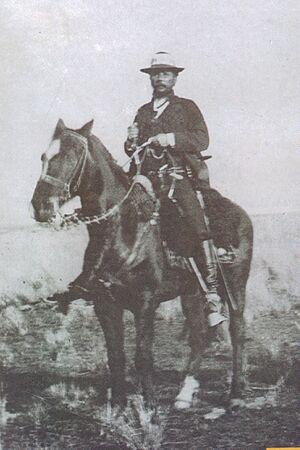Aparicio Saravia facts for kids
Quick facts for kids
Aparício Saravia da Rosa
|
|
|---|---|
 |
|
| Born | August 16, 1857 Cerro Largo, Uruguay |
| Died | September 10, 1904 Rio Grande do Sul, Brazil |
| Allegiance | National Party |
| Rank | General |
| Battles/wars |
|
Aparicio Saravia da Rosa (born August 16, 1856 – died September 10, 1904) was an important Uruguayan politician and military leader. He was a member of the Uruguayan National Party. He also led several revolutions against the Uruguayan government.
Contents
Early Life and Beginnings
Aparicio Saravia was born in Cerro Largo, Uruguay. He was the fourth of thirteen children. His parents were Brazilians, and his family name was originally "Saraiva." Later, it was changed to "Saravia" to sound more Spanish.
He grew up and learned mostly in the countryside. But he also had some higher education. When his father passed away, the Saravia brothers inherited a very large farm called Estancia El Cordobés. This farm was in the Cerro Largo area, right on the border with the Brazilian state of Rio Grande do Sul.
The borders between Brazil and Uruguay were not always clear back then. Because of this, the Saravia brothers had strong connections to Rio Grande do Sul and its revolutionary groups.
Aparicio Saravia started his military actions when he was quite young. People believe he took part in the Revolution of the Lances (Revolución de las Lanzas) from 1870 to 1872. This revolution was led by Timoteo Aparicio against the government.
In 1875, he and two of his brothers joined the Tricolor Revolution (Revolución Tricolor). In 1877, he married Cándida Díaz. She was the niece of a leader from the Colorado Party.
Federalist Revolution in Brazil
Gumercindo Saraiva, Aparicio Saravia’s older brother, played a big part in a federalist revolution in Rio Grande do Sul, Brazil. The Saravia brothers led a group of 400 Uruguayan lancers. These were soldiers who fought on horseback with long spears. They carried a special flag that said Defensor da lei, which means "Defender of the Law." This flag had been used before by Manuel Oribe and was important to the National Party.
Gumercindo Saraiva died in 1894. After his death, Aparicio Saravia took over the revolutionary forces. He earned the rank of General. He and his Uruguayan volunteers fought in the Battle of Passo Fundo. Even though the revolution started to fail by 1895, Aparicio Saravia gained a lot of respect. Newspapers in Montevideo often wrote about his brave actions.
Leader of the Blanco Party
The Peace of April (La Paz de Abril) was signed on April 6, 1872. This agreement ended the Revolution of the Lances. It tried to make the Blanco and Colorado Parties work together. But there was still tension, especially during the time of President Julio Herrera y Obes. The Blanco Party started to look to Saravia for leadership.
After Herrera y Obes, Juan Idiarte Borda became president. This made the Blanco Party angry. They felt left out of the government. They believed the Colorado Party had broken the Peace of April agreement. In 1895, Aparicio Saravia went to Montevideo to represent his region. In November 1896, he started to push for a new revolution. However, government troops quickly moved against the revolutionaries, and they had to scatter.
In March 1897, Aparicio Saravia led a revolutionary force from the border with Brazil at Aceguá. Other leaders also led forces from different areas. Aparicio Saravia’s forces were defeated at Cuchilla del Arbolito. His younger brother, Antonio, died in this battle.
President Idiarte Borda was later assassinated. Juan Lindolfo Cuestas then tried to make peace with the Blanco Party. They signed an agreement called the Pact of La Cruz (Pacto de La Cruz) on September 18, 1897.
Within two years, Lindolfo Cuestas gave the presidency to José Batlle y Ordóñez for a short time. Aparicio Saravia became a strong opposition leader during this period. He had the support of his own army. He was like an unofficial second leader of the country. José Batlle y Ordóñez led the government in Montevideo, while Saravia led his forces in the countryside.
Saravia again pushed for revolution. But a civil war was avoided by a diplomatic meeting. This led to a new agreement signed at Nico Pérez on March 22, 1903. However, Saravia later felt that this new pact had also been broken. So, war broke out in 1904 between the government forces and Saravia's followers, known as saravistas. There were battles at Mansavillagra, Illescas, and Tupambaé. The most important battle happened at Masoller on September 10, 1904.
Saravia was badly hurt in this battle. He was shot in the stomach while leading his troops. His friends managed to take him across the border into Brazil. He was taken to a ranch near Santiago, Rio Grande do Sul. He suffered for 10 days from a serious infection called peritonitis before he died from his wounds.
After his death, the Saravian Revolution failed. On September 24, 1904, the Peace of Aceguá was signed. This agreement finally brought peace and stability to Uruguay. The Saravian Revolution was the last civil war in Uruguay's history.
Aparicio Saravia was first buried in Brazil. But in 1921, his remains were moved to the cemetery of Buceo in Montevideo. Later, they were moved again to Santa Clara de Olimar, where he was buried next to his family.
See Also
 In Spanish: Aparicio Saravia para niños
In Spanish: Aparicio Saravia para niños


